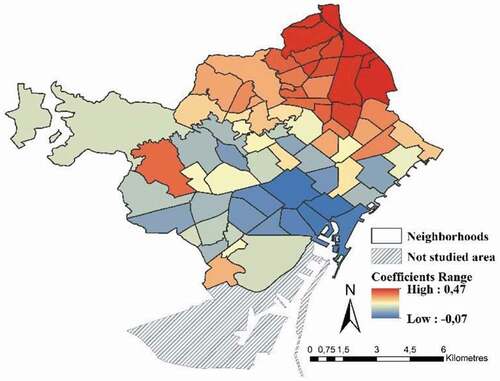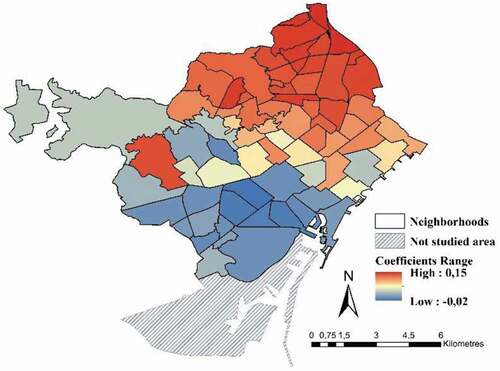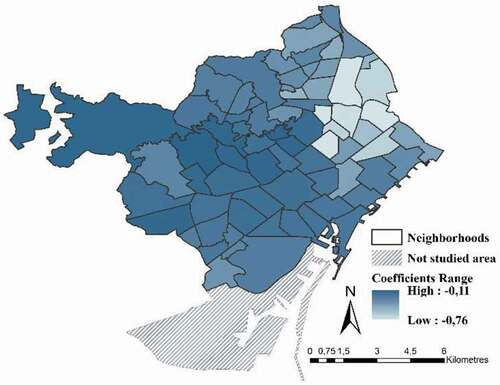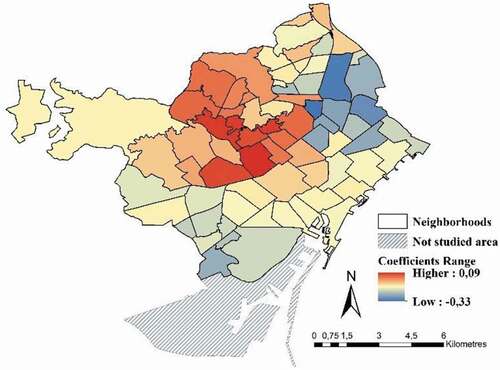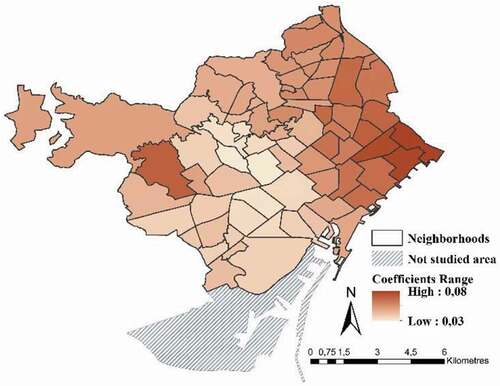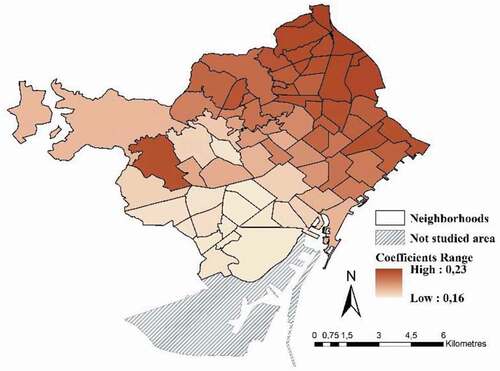 ?Mathematical formulae have been encoded as MathML and are displayed in this HTML version using MathJax in order to improve their display. Uncheck the box to turn MathJax off. This feature requires Javascript. Click on a formula to zoom.
?Mathematical formulae have been encoded as MathML and are displayed in this HTML version using MathJax in order to improve their display. Uncheck the box to turn MathJax off. This feature requires Javascript. Click on a formula to zoom.ABSTRACT
The existence of works proving the possible relationship empirically that Airbnb lodgings could have with crime in Spain is not known. This research analyzes the relationship between Airbnb lodgings and crimes against the properties and people in Barcelona’s neighbourhoods. To achieve this, we use an ordinary least squares regression model and a geographically weighted regression model. The results show a significant and positive relationship between the higher density of Airbnb lodgings and the higher crime rates in the neighbourhoods, especially of patrimonial nature. Divided by type of leased space, the Airbnb homes, in which the guest shares a room with other guests, show a higher relationship with crimes against property and people. The results of the local model show a spatial heterogeneity in all variables used, indicating the need to address non-stationary spatial processes that reveal hidden patterns. However, the only variable that shows statistically significant local variability is the total Airbnb lodgings variable. Finally, we discussed some unexpected results, proposing some future lines of research.
1. Introduction
Airbnb is a form of shared economy in which an owner (the host) rents out his house or room to a guest. The only intermediary between both parties is a digital platform that manages reservations and the payment for accommodation. Due to its implications in the housing market, the high proliferation of this type of lodgings has attracted the attention of policy makers, urban planners, sociologists, and a wide variety of other professionals.
In the academic ground, literature primarily focuses on the impact Airbnb lodgings might have on gentrification and turistification processes (Wachsmuth and Weiser Citation2018; Robertson, Oliver, and Nost Citation2020). However, studies focused on the relationship between Airbnb lodgings and crime rates is quite scarce. Those investigations are based on different theoretical approaches and methods, and analyse the relationship between Airbnb and crime in different cities, so results are mixed and not generalizables.
The sparse research on Airbnb and crime are mainly sustained on the literature on tourism and crime, which generally showing that the increase in tourism leads to a rise in crime in the area (Fuji and Mak Citation1980; Mawby Citation2010; Montolio and Planells-Struse Citation2016; Recher and Rubil Citation2020). The relationship can be mainly explained based on the routine activities theory (Cohen and Felson Citation1979) This theory postulates that crime is an event which happens when three elements converge in space and time: a motivated criminal, an adequate objective, and the absence of a guardian capable of stopping the crime with his vigilance. Following Montolio and Planells-Struse (Citation2016), the arrival of tourists can change these three elements differently depending on whether they act as criminals or victims. When they act as criminals, the concentration of tourists could result in a crowd of motivated criminals in certain areas. According to Shiner (Citation2010), tourism associated with visitors as criminals is related to drug use and nightlife activities, leading to particular disorders and being responsible for a series of crimes.
If tourists are the victims, the areas that produce a concentration of them represent an accumulation of adequate targets. Several papers have provided a description of the main characteristics of tourists and their behaviour that makes them suitable to be targeted by criminals. For example, tourists often carry valuables such as cash or a camera (Xu, Pennington-Gray, and Kim Citation2018), they are easily identifiable by the places they go and their clothing (Crotts Citation1996), they involve in behaviours such as frequenting bars and nightclubs or travelling to remote and unknown areas (Chesney-lind and Lind Citation1986) and they sometimes are seen by criminals as strangers exploiting their country and ignoring local traditions, so offenders can neutralize the image of the tourist as a victim (Mawby Citation2010).
Two of the three studies on Airbnb and crime identified are based on the above approach, arguing that Airbnb leads to a spatial concentration of suitable targets (tourists) in absence of surveillance, so crime will rise in the area. Thus, Xu, Pennington-Gray, and Kim (Citation2018) warn that Airbnb lodgings lack enough security mechanisms than other facilities such as hotels. The absence of estate managers, lifeguards, etc. in shared lodgings increases the risk of victimization, given the lack of surveillance. However, using a geographically weighted regression (from now, GWR), they found that in the city of Florida Airbnb lodgings have a negative relationship with crime rate, except when the guest shares a room with other visitors, that shows a positive relationship with higher crime rates. For his part, Han and Wang (Citation2019) argue that the absence of hosts on the property and the lack of incentives for owners to evaluate guests can provoke illegal activity in the community. The authors found a positive relationship between home sharing and the increase in crime rate in the cities of Nueva York and San Francisco.
While the crime opportunity approach is the one most used to explain the relationship between crime and tourism, and hence to explore the relationship between Airbnb and delinquency, other perspectives have been taken in the scarce literature on Airbnb and crime. This is the case of Garate, pennington-Cross, and Zhao (Citation2020), who claim that Airbnb is responsible for a gentrification process that results in reduced crime rates due to improved housing in the community, the enrichment of homeowners and the increase in the community stability thanks to a fewer number of foreclosures. The latter would improve conditions for social cohesion, as well as trust in neighbours and active engagement. The authors find that, in the city of Milwaukee (Wisconsin), a 10% increase in the number of Airbnb accommodations reduces both property crime and crime against people more than 25% in neighbourhoods with the highest economic status.
It is worth noting that all previous research test the relation between Airbnb and crime in American cities, so the results could be different from other cities where the socioeconomic and cultural background is quite distinct. Furthemore, some cities are highly dependent on tourism for the maintenance of their economy. Thus, Airbnb is likely to have very different consequences on crime in these cities. For example, the above claimed positive gentrification process – supously triggered by the accumulation of Airbnb lodgings in the area – could have an opposite effect in a very touristic country like Spain. In this country, several studies have shown how the intense tourism activity is linked to a process by which the longstanding population is replaced by a more young and mobile one (García Herrera, Smith, and Mejías Vera Citation2013; Cocola-Gant Citation2018; Jover and Díaz-Parra Citation2019). This process could have serious consequences for both criminal opportunities and the lack of social cohesion in the neighbourhood. For example, Cocola-Gant and López-Gay (Citation2020) found that those very touristic neighbourhood in Barcelona (Spain) are chosen by lifestyle migrants for the settlement. These migrants are transnational, do not speak the local language, they wear the similar style of clothes, they stay or live in the same areas and go to places where they meet up with their compatriots (Torkington Citation2010). But the main characteristic is that this new transnational short-terms residents share space and lifestyles with visitors rather than mixing with the host community (Cocola-Gant and López-Gay Citation2020), so the social ties could be broken.
In a similar vein, Mawby (Citation2010) warns that the high number of tourists and the constant rotation of these, coupled with the lack of relationship between the residents, reduces both the ability and willingness of neighbours to act as guardians. As a result, we can expect that a reduction in social control will accompany the concentration of appropriate targets (tourists) because high residential mobility compromises the mechanisms generating social capital and collective efficacy. This could be especially true in top touristic cities, since, as mentioned above, in the inner-city neighbourhoods a process could exist by which the tradicional local residents – unable to keep paying high rental prices – are being displaced by a more inestable and affluent population. This floating population converges in the same space with tourists, so the area is almost ‘a foreing only enclave’ in which the residents are not worried about what is happening in the neighbourhood cause they will be there only a short time.
Considering all this, it would be necessary to study the possible relationship that Airbnb lodgings could have with crime rates in Spain. This type of studies do not exist in the country, even though the data shows an explicit spreading of this type of shared economy in the lodging sector in that country. Airbnb launched in Spain in 2009, and only from June to August 2018, registered 3.6 million visitors who used this platform to find lodging. However, in line with international literature, Spain’s interest in the repercussions of these lodgings focuses on gentrification and housing market issues (Yrigoy Citation2017; Gil and Sequera Citation2018; Adamiak, Szyda, and García-Álvarez Citation2019), and, less frequently, on social and local effects (Cocola-Gant and Pardo Citation2017; Cocola-Gant and López-Gay Citation2020).
Therefore, to fill this gap, this paper analyzes the relationship between Airbnb lodgings and crime in a very touristic Spanish city: Barcelona. We thus test this relationship in a city where the high concentration of tourists in some areas overlaps with other dynamics that lead to a more mobile ‘population’ that attracts not only visitors but also lifestyle migrants.
We hypothesize that, since the spatial concentration of Airbnb lodgings contributes to the concentration of tourists in certain areas, and since the neighbourhoods with a more intense tourism activity are those that attract a more inestable population, a higher Airbnb density in these areas will be associated with an increase in crime rate, especially of property nature. In particular, four hypotheses are the backbone of this work: (i) the increased concentration of Airbnb lodgings is positively related to crime, (ii) the relationship between Airbnb lodgings and property crime is higher than between crimes against individuals, (iii) the relationship between Airbnb lodgings and crime rates will be more significant in lodgings with shared rooms and (iv) the relationship between Airbnb lodgings and crime varies by area, following non-stationary spatial processes.
The structure of the paper is as follows: Section II describes the data and method used for the scope of the results, as well as the study region. Section III describes the results for both global and local models, followed by a discussion on the findings and their possible implications in section IV, closing the present study.
2. Methodology
2.1. Data, variables and study region
We selected the city of Barcelona (Spain) to test the relationship between Airbnb and crime rate. In 2014, the city ranked fifth in Europe in terms of international tourists visiting the country and ranking in the top twenty-five favourite destinations for international tourism (Gutiérrez et al. Citation2017). Besides, according to the data provided by Airbnb’s portal, it shows the most significant spread of this type of lodging in Spain, with a current total of 18,302 different lodgings. Another essential reason we chose Barcelona as a case study is Airbnb’s spatial concentration pattern. Gutiérrez et al. (Citation2017) employs local indicators of spatial association and notes that Airbnb is much more prevalent than hotels in the midtown area. Also, there’s a greater spatial cluster between the most frequented points of the city and Airbnb, than between those and the hotels. This distribution pattern could have a greater impact on crime since Airbnb concentrates tourists in places that, in themselves, are already frequented routes of the city, resulting in an agglomeration of potential victims and/or potential criminals. Also, as indicated previously, some neighbourhoods in Barcelona are experiencing a transnational gentrification process by which the longstanding population is being replaced by a floating one (Cocola-Gant Citation2018; Cocola-Gant and López-Gay Citation2020).
We collected the data used in this research from three main sources. We obtained the number of crimes against property and people through the Department of Interior of the Generalitat of Catalonia, and represent those crimes recorded in the city’s public streets in 2017. The file handed over by the regional police, contains the type of crime and the coordinates of the place where each crime happened. To obtain the total number of crimes in each neighbourhood, which corresponds to the spatial analysis unit in this study, we proceeded to perform a spatial union between the layer containing the crimes (points) and the layer representing each of the neighbourhoods (polygons). It is important to note that we removed the community of the Marina del Prat Vermell from the study. This neighbourhood has traditionally been an industrial zone, and its inclusion can skew results by behaving as an anomaly, given the smaller population residing in it and its wide area in Km2 compared to the low number of crimes it registers. In other neighbourhoods of the city such as the Gothic or the Poblenou quarters some very specific areas maintain a commercial or industrial use, but these are very limited areas within the neighbourhood (one or two streets), not almost all of it.
Regarding crimes against property, we considered five types of them for this study: petty theft, theft, theft with force, robbery with violence and/or intimidation and carjacking. We represent crimes against people in three forms: homicide, rape, and injury. The total number of crimes included in the sample is 55,911 crimes.
We extracted the information on Airbnb locations from the open data portal the platform offers to the public.Footnote1 The data can be downloaded and contain extensive information on the site of the lodging in coordinates, represented by longitude and latitude, the type of room (whether shared, private, or if the entire property is available) and any other kind of info. shows descriptive statistics for each criminal typology (dependent variables) and for independents and control variables. shows the descriptive statistics of all variables used in this paper.
Table 1. Descriptive statistics of the data used
To construct the control variables used in the model, we downloaded a set of data available from the open data portal of Barcelona, containing census information at the neighbourhood level. summarizes the variables used in this paper and their operationalization.
2.2. Empirical strategy
To test the hypothesis 1, 2 and 3, we used an ordinary linear least squares regression model (from now on OLS). Each model has the same control variables (socioeconomic status, population density, and ethnic heterogeneity) and a different independent variable: a total of Airbnb lodgings, Airbnb with room shared, Airbnb with a private room and Airbnb offering the full property. We repeat the process, using crime against property and people as dependent variables.
A GWR model is used to test hypothesis 4. This type of local regression, as opposed to the global character of OLS models, can estimate a series of parameters for each neighbourhood, which allows observing the presence of spatial heterogeneity, or what is the same, the change in the relationships between independent variables and dependent variables throughout space.
In the GWR, the regression model’s calibration will give more weight to observations near a regression point i than to that further set of data. GWR considers the possibility of local variations in relationships, considering the spatial point from which we take each observation in the set of data. Thus, assuming a number n of observations, for the observation i in the location (ui, vi), the GWR formula is expressed by EquationEquation (1)
(1)
(1) (Oshan et al. Citation2019a):
where (ui, vi) is the intercept, (ui, vi) denotes the coordinates of the i-th point in space, and k (ui, vi) are the coefficients of the continuous function k (u, v) for a k number of independent variables at the point i. Meaning, it becomes possible to be a continuous surface of the parameter values, and measurements of this surface are taken at specific points to denote the spatial variability of the surface.
Considering the GWR model results are susceptible to the type of bandwidth selected, we estimated the most appropriate value using a golden search criterion using the MGWR software, with an optimization criterion of type AICc. This way, the value of the selected bandwidth will be the one with a lower AICC value associated with it. The curve of the chosen weighting function has been that of Gaussian type, with an adaptive kernel given the different distances between the centroids of each polygon in the neighbourhood, used as regression point i in the GWR.
In order to test the statistical significance of the spatial variability in local parameters that the GWR model could reveal, we carried out a Monte Carlo non-stationarity test (Fotheringham, Charlton, and Brunsdon Citation1998). For this, we use the MGWR software mentioned above. By default, this software carries out 1000 permutations. In the first one, the local parameter estimates are derived. The remaining 999 permutations repeatedly derive new local parameter estimates after randomly rearranging the data points to measure whether the variability of each parameter surface could have arisen by chance (Oshan et al. Citation2019b).
3. Results
3.1. Results of the global model
show the results for crimes against property and individuals, respectively. The relation of Airbnb lodgings with crime density is, in all cases, positive and significant, although the magnitude of the ratio is lower for crimes against people than for crimes against property. Besides, the ratio of determination (R2-adjusted) is, in all cases, higher in models of crimes against property.
Table 2. Dependent, independets and control variables
Table 3. Results of the global model for crimes against property
Table 4. Results of the global model for crimes against people
For both criminal categories, the type of lodging whose coefficient is higher is the one in which the guest shares a room with other visitors, followed by private rooms and the end, the whole house. Thus, when in a community, the density of Airbnbs with shared rooms increases one unit, the number of crimes against property per km2 increases by 2.85 (exponential of 1.046 = 2.85), and the number of crimes against people does so by 2.47 (exponential of 0.906 = 2.47).
Regarding the control variables, all show the expected result, although some are no longer significant depending on the type of room the guest occupies in the house. For example, ethnic/cultural heterogeneity shows a negative result, indicating that the more heterogeneous the neighbourhood is, culturally speaking, the greater the crime rate in it will be. Also, this variable is significant in crimes against a property for the total Airbnb lodgings and in the types of lodgings where the guests have to share a room. However, in the case of crimes against people, it only shows a significant relationship with the case of the shared room.
Socioeconomic status is, in all cases, positive and significant for all crimes, although its coefficient is greater in crimes against people. Population density is only substantial for crimes against property, with a rather small ratio size.
Observing the ratios of determination show that the model with a higher R2-adjusted for crimes against property is the one that incorporates the shared room as an independent variable, which explains 73% of the variance in crime density. For crimes against people, all models have a value of R2-adjusted lower than those obtained in crimes against property.
Even though the value of the different R2-adjusted is high in cases of crimes against property, however, approximately 30% of the variance remains unexplained. In the case of crimes against people, this unexplained percentage is roughly 50%. The use of local regression models, such as GWR, allows not only to detect spatial variations in the relationships between model variables but also to obtain higher R2-adjusted values. It is, therefore, necessary to apply a local model.
3.2. Local model results
We will only show the results of the GWR model in which we used the total Airbnb lodgings as a separate variable for reasons of extension. The findings are presented for both criminal typologies both in tables and maps. show the results for crimes against property and people, respectively. In both categories, the variable of interest and the variable of control vary concerning the variable dependent throughout space. For example, when the density of total lodgings increases one unit, in some neighbourhoods, the crime density against properties increases by 1.34, while in others, it increases by more than 2.06. Signs associated with ratios also vary. For example, for both types, population density has a positive relationship in some areas of Barcelona, while for others, this relationship is negative.
Table 5. Results of the local regression model for crimes against properties
Table 6. Results of the local regression model for crimes against people
To find the amount of variations in each Barcelona’s neighbourhood, we represent the results of the RGP in a variety of maps contained in –8.
The ratio associated with the variable of the total of Airbnb lodgings remains positive for the entire study of the region in the case of crimes against property (see ). Although midtown neighbourhoods, which tend to record the highest number of crimes, have a positive coefficient (Airbnb is related with an increase of between 1.69 and 1.80 crimes per km2), the highest values are especially concentrated in some neighbourhoods in the west and the southeast of the city. On the other hand, the density of Airbnb lodgings has a lower relationship between crime in the northeast of the city.
Regarding the relationship between Airbnb lodgings and crime against people, the results are similar to those obtained for crimes against property. Ratios have a positive sign in all neighbourhoods (). However, some neighbourhoods show a higher ratio than those found in crimes against property. In particular, there is a belt that runs through from east to west, located on the south side of the city (areas where an increment of a unity in Airbnb Kernel density is related with an increase of 2.3 crimes per km2). The relationship between Airbnb and crime against people is reduced as the distance to the midtown increases, showing a coefficient of 0.42 in neighbourhoods in the northeast. That is, the increase of an unity in the Airbnb Kernel density is related with an increment of 1.52 crimes against people per km2.
Figure 1. Airbnb and property crimes.Footnote2
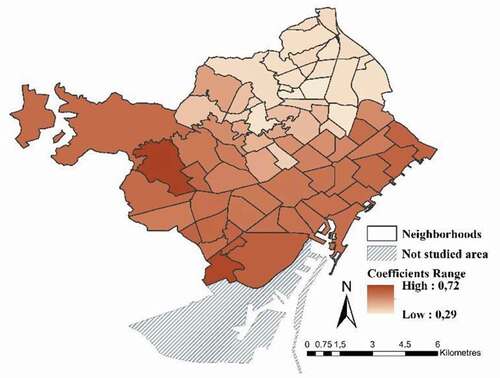
Figure 2. Airbnb and crimes against people.Footnote3
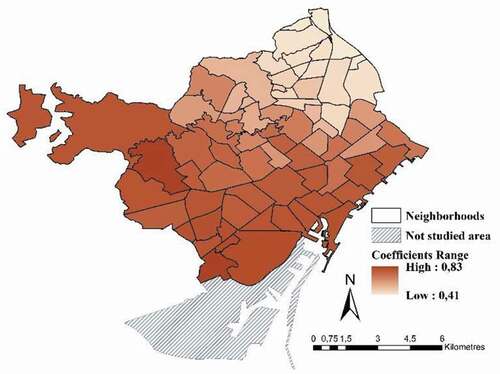
Population density has peculiar behaviour in its influence on crimes against property () and people (). Thus, and especially in midtown neighbourhoods, this variable exhibits the lowest and even negative values in specific neighbourhoods, which means that in some regions of the midtown, the lower population density is related to a higher number of crimes against property per km2 (even if the effect is small).
For crimes against property, ethnic/cultural heterogeneity shows a negative ratio in all neighbourhoods (), which means that the increased presence of distinct ethnic or cultural groups is related to a higher number of crimes against property per km2. However, in the case of crime against people, relationships vary much more by neighbourhood ().
Socioeconomic status is similarly related to both categories of crime (). The increased presence of several unemployed people with low incomes and low educational levels is associated with a higher incidence of crimes of both types. However, its effect is greater in the eastern districts of some of the midtown areas. Nonetheless, the impact of socioeconomic status is somewhat greater on crimes against people.
As indicated previously, in order to test if the spatial variability in local parameters shown in and in , is statistically significant, we carried out a Monte Carlo non-stationarity test. For both property crime and crime against people, results show that the only significant spatial variability is found in the local parameter estimates for the total Airbnb variable. shows the results for the Monte Carlo test.
Table 7. Results of Monte Carlo non-stationarity test
5. Discussion and conclussions
This research analyzes the relationship between the concentration of Airbnb lodgings and crime in a very touristic Spanish city. Before discussing the results it is important to consider that the results shown here have to be interpreted with caution, as they cannot be expanded to other cities distinct from Barcelona. To be able to generalize the results it is necessary to include more cities with very different characteristics. Barcelona is a very touristic city, so Airbnb could be related with crime in a distinct way because of the socioeconomic dynamics related with the tourism industry.
This paper hypothesizes that, given that the accumulation of these lodgings contributes to the concentration in the area of targets suitable for crime, especially against property, and compromises the mechanisms generating social capital and collective efficacy, it is expected that a higher density of such lodging is related to an increased crime rate. The results found here support this hypothesis. The density of these lodgings is associated with crime in a positive and significant way, implying that a higher value in Airbnb lodging density in the neighbourhood is associated with a higher number of crimes per km2.
Therefore, the argument referred to by Garate, pennington-Cross, and Zhao (Citation2020) that Airbnb lodgings contribute to improving community stability, and social control processes do not seem to operate in the same manner in Barcelona. The hypothesis presented by the author of this research opposes the previously Garate et al.’s hypothesis regarding gentrification processes. The increased accumulation of Airbnb lodgings, especially those in which the owner is not present, encourages residential rotation. Meaning, it contributes to a continuous flow of short-stay residents that makes it challenging to establish ties between neighbours. These short-stay residents converge in this neighbourhood with a floating population due to a transnational gentrification process. According to the systemic model of Kasarda and Janowitz (Citation1974), the time spent in the community is the main determining factor for the development of feelings of belonging to the neighbourhood and for the active participation in the problems of the community.
The findings derived from the global regression model also support the second hypothesis, that is, the relationship between Airbnb lodgings and property crime is higher than between crime against people, since the value of the ratios in each of the types of rooms studied is higher for crimes of the first type than for the second. Similarly, the proportion of variance explained by the property model is approximately 20% higher concerning violent crimes. Since criminal opportunities are specific to each type of crime, the results are consistent if criminals see tourists as good targets, as they often carry valuables and cash. However, the local regression model reveals that in some neighbourhoods of Barcelona, Airbnb lodgings have a higher relationship with crime against people than with property. This fact would not have been revealed if the analysis had been limited to a regression model that assumes parametric stability.
The hypothesis 3 is confirmed with regard to the relationship with the crime depending on different uses of lodging. Both crimes against property and people are more related to Airbnb lodgings where the guest shares a room with another person. A plausible explanation for crimes against property is that sharing a room with another unknown guest can generate mistrust. So, the tourist chooses to take the main valuables instead of leaving them in the room, thus increasing the risk of a crime happening on the street. The explanation of the greater effect of the shared room on crimes against people is less straightforward. If the visitor chooses to rent a shared room, they are more likely to travel alone, which would increase the risk of being a victim of a crime compared to tourists visiting with family or friends. However, although plausible, these explanations are speculative, and more in-depth studies are needed to test them empirically.
The second type of lodging that shows the higher relationship between both criminal categories is the private room, followed by shared houses, which occupies the last place. Although Xu, Pennington-Gray, and Kim (Citation2018) expect ownership to be more related to crime due to the absence of the homeowner as a capable guardian, the fact is that Airbnb lodging, when renting the full property, is usually rented by a group of people. Renting with a group of friends or family implies an intention to mutually protect their properties, which would be less likely when the room is private, since living with strangers, even when only sharing common spaces with them, makes the crime more likely.
Along with the Airbnb lodging, the variable that shows greater stability in its ratio and significance is the socioeconomic status. This indicator shows, in all cases, a positive association with both types of crime, although its relationship is greater when it comes to crime against people. This finding is consistent with the results achieved in works such as Messner et al. (Citation1999), which found that the areas with the lowest economic influx tend to concentrate on homicide and other violent crimes.
Particularly interesting is also the value of the coefficient of the socioeconomic status variable in the areas of the city’s 1st district (the middletown area). In this case, the value, although positive and significant, is considerably lower than in other neighbourhoods. However, the neighbourhoods of Ciutat Vella are the ones that experience the highest number of crimes committed. One reason may be that, although the population with less economic status resides in this area, crime occurs against the visitors. So the effect may be caused more by the status of tourists than by the residents. Another reason could be associated with a gentrification process by which poorer people are replaced by a more affluent population.
The presence of spatial variations in the relationships between variables is, in many cases, marked, which supports hypothesis number four regarding the presence of spatial heterogeneity. Nonetheless, in spite of the variations in local parameters estimated, Monte Carlo spatial variability test shows that the only statistically significant variability can be found in the total Airbnb variable. This means that the relationship between Airbnb and crime is significantly different throughout the region of study. The hypothesis that GWR models return a higher ratio of determination is also confirmed.
The results achieved in this research may be of interest to the local government, usually focusing on reducing the crime rate in some regions of the city. Not only to ensure the safety of its citizens but also to avoid a negative impact on tourism, especially when this is the primary source of profits for the city or country. Han and Wang (Citation2019) showed that the implementation of a policy to limit Airbnb lodging expansion resulted in a reduction in crime in the cities of New York and San Francisco. In Barcelona, the City Council has implemented a series of restrictive measures that have resulted in the closing of a large number of Airbnb lodging operating without a licence. Future studies should analyse the impact of these measures on Barcelona’s crime rates.
However, several limitations are recognized in this paper. First, the results shown here must be interpreted with caution, as they cannot be expanded to other cities distinct from Barcelona. Future studies could expand the actual research and collect more data from other cities in the same country or continent. By this way, results could be more generalizable and make it possible to check if the relationship between Airbnb lodgings and crime depends on the regions under study.
Second, it is necessary to incorporate more control variables into the model that could explain the variability in crime density between Barcelona’s different neighbourhoods, taking into account space and time. Together with the socioeconomic status, the density population and the cultural heterogeneity, other control factors such as the land uses in the neighbourhood, the intensity grade of the touristic activity in the area and the levels of social cohesion should be added to make sure that, after controlling all of them, Airbnb lodgings keep the positive relationship with crime found in this paper. By incorporating them it is also possible to explore the intermediate mechanims which could be working in the relationship between Airbnb and crime (for example, it would be possible to know if a higher amount of these lodgings reduce social cohesion levels, which increase the crime rate in the area).
Third, it is necessary to note that the results may be affected by the modifiable areal unit problem (Openshaw Citation1984; Openshaw and Taylor Citation1979), so that the findings derived from the regression models could be different at a different scale and with a different zoning system. Testing the results in a finer scale has not been possible for this paper, since data for variables operationalization is not available for other spatial units smaller than neighbourhood. To check the extension by which the results vary depending on the size of the spatial units, future research could use a finer scale at the beginning. After getting the results for smaller spatial units, a higher level of aggregations could be used and then to test if the new results are far different from the former.
Fourth, it is necessary to check the presence of spatial autocorrelation in residues, as it can skew the OLS results. If any of the spatial dependence forms are found in the regression model, the best alternative for the OLS model is using spatial regression models based on the maximum likelihood principles, such as spatial lag or error models (Anselin Citation1988).
Finally, it is necessary to consider the possibility that the data provided by Airbnb does not completely correspond to reality. In cities with strong Airbnb regulation like Barcelona, some owners may register their properties as a whole house, for example, while in practice renting each of the rooms separately. Future research studying the relationship between Airbnb lodgings and crime in cities with strong Airbnb regulations must keep this in mind. A possible future way to deal with this situation is to search on the Airbnb platform the amount of Airbnb rooms availables for renting in lodgings supposedly registered as ‘complete house’. In case of this number is more than one or two, it might exist enough arguments to considere and count this lodging as an shared room Airbnb type Future research should address these aspects and move towards more in-depth knowledge, given the mixed results in the scarce literature on the relationship between Airbnb and crime.
In spite of these limitations, this paper fills the gap in the Spanish literature and finds promising results to consider by a range of professionals in the field of crime prevention and urban and housing policy.
Acknowledgements
I would like to thank Mossos d’Esquadra (the Regional Police Office of Catalonia, Spain) for sharing the crime data used in this paper. This dataset is rarely available in Spain so the development of this paper would not be possible without the collaboration of that police Office.
Disclosure statement
No potential conflict of interest was reported by the author.
Notes
1. Data can be gathered from http://insideairbnb.com/barcelona/.
2. petty theft, theft, theft with force, robbery with violence and/or intimidation and carjacking.
3. The category ‘crime against people’ contains the following three offences: rape, homicide and injury.
4. This index is a general indicator of concentration or heterogeneity, whose values range from zero (maximum heterogeneity) to one (maximum homogeneity).
References
- Adamiak, C., B. Szyda, and D. García-Álvarez. 2019. “Airbnb Offer in Spain-Spatial Analysis of the Patterns of Determinants of Its Distribution.” International Journal of Geo-Information 3: 1–26.
- Anselin, L. 1988. “Lagrange Multiplier Test Diagnostics for Spatial Dependence and Spatial Heterogeneity.” Geographical Analysis 20 (1): 1–17. doi:https://doi.org/10.1111/j.1538-4632.1988.tb00159.x.
- Chesney-lind, M., and I. Y. Lind. 1986. “Visitors as Victims Crimes Agaist Tourists in Hawaii.” Annals of Tourism Research 13 (2): 167–191. doi:https://doi.org/10.1016/0160-7383(86)900368.
- Coba, E. 2015. Análisis geoestadístico de la delincuencia para Quito urbano usando Geoda (tesis de maestría). Quito, Ecuador: Universidad de Francisco de Quito.
- Cocola-Gant, A. 2018. “Tourism Gentrification.” In Handbook of Gentrification Studies, edited by L. Lees and M. Phillips, 281–293. Cheltenham and Northampton: Edward Elgar Publishing.
- Cocola-Gant, A., and A. López-Gay. 2020. “Transnational gentrification, tourism and the formation of ‘foreign only’ enclaves in Barcelona.” Urban Studies 1–19. doi:10.1177%2F0042098020916111.
- Cocola-Gant, A., and D. Pardo. 2017. “Resisting Tourism Gentrification: The Experience of Grassroots Movements in Barcelona.” Urbanistica Tre, Giornale Online Di Urbanistica 5 (13): 39–47.
- Cohen, L., and M. Felson. 1979. “Social Change and Crime Rate Trends: A Routine Activity Approach.” American Sociological Review 44 (4): 588–608. doi:https://doi.org/10.2307/2094589.
- Crotts, J. 1996. “Theoretical Perspectives on Tourist Criminal Victimisation.” Journal of Tourism Studies 1: 2–9.
- Echazarra, A. 2014. La delincuencia en los barrios. Percepciones y reacciones. Barcelona, España: Obra Social La Caixa.
- Fotheringham, A. S., C. Brunsdon, and M. Charlton. 2002. Geographically Weighted Regression. The Analysis of Spatially Varying Relationships. NewCastle, UK: John Wiley & Sons.
- Fotheringham, A. S., M. Charlton, and C. Brunsdon. 1998. “Geographically Weighted Regression: A Natural Evolution of the Expansion Method for Spatial Data Analysis.” Environtment and Planning A 30 (11): 1905–1927. doi:https://doi.org/10.1068/a301905.
- Fuji, E., and J. Mak. 1980. “Tourism and Crime; Implications for Regional Development Policy.” Regional Studies 14 (1): 27–36. doi:https://doi.org/10.1080/09595238000185031.
- Garate, S., A. pennington-Cross, and W. Zhao. 2020. The Effect of the Shared Economy on Crime: Evidence from Airbnb. Article submitted for publication. https://drive.google.com/file/d/1UlIhAbJsSMHH-7QUDS7mDjx1H3ix6K3T/view
- García Herrera, L. M., N. Smith, and M. A. Mejías Vera. 2013. “Gentrification, Displacement, and Tourism in Santa Cruz de Tenerife.” Urban Geography 28 (3): 276–298. doi:https://doi.org/10.2747/0272-3638.28.3.276.
- Gil, J., and J. Sequera. 2018. “Expansión de la vivienda turística y nuevas resistencias. El caso de Airbnb en Madrid.” EMPIRIA, Revista de Metodología de Ciencias Sociales 41: 15–32.
- Gutiérrez, J., J. C. García Palomares, G. Romanillo, and M. H. Salas Olmedo. 2017. “The Eruption of Airbnb in Tourist Cities: Comparing Spatial Patterns of Hotels and Peer-to-peer Accommodation in Barcelona.” Tourism Management 62: 278–291. doi:https://doi.org/10.1016/j.tourman.2017.05.003.
- Han, W., and X. Wang. 2019. “Does Home Sharing Impacts Crime Rates? A Tale of Two Cities.” 40th International Conference on Information Systems, ICIS, Association for Information Systems. Munich, Germany. https://aisel.aisnet.org/icis2019/sustainable_is/sustainables_is/
- Harries, K. 1999. Mapping Crime. Principle and Practice, 1–206. United States: National Institute of Justice.
- Jover, J., and I. Díaz-Parra. 2019. “Gentrification, Transnational Gentrification and Touristification in Sevilla, Spain.” Urban Studies 1–16. https://journals.sagepub.com/doi/10.1177/0042098019857585.
- Kasarda, J. D., and M. Janowitz. 1974. “Community Attachment in Mass Society.” American Sociological Riview 39 (3): 328–339. doi:https://doi.org/10.2307/2094293.
- Mawby, R. 2010. “Property Crime and Tourists.” In Tourism and Crime: Key Themes, edited by D. Botterill and T. Jones, 21–36. Oxford: Goodfellow Publisher .
- Messner, S. F., L. Anselin, R. D. Baller, D. F. Hawkins, D. Deane, and S. E. Tolnay. 1999. “The Spatial Patterning of County Homicide Rates: An Application of Exploratory Spatial Data Analysis.” Journal of Quantitative Criminology 15 (4): 423–450. doi:https://doi.org/10.1023/A:1007544208712.
- Montolio, D., and S. Planells-Struse. 2016. “Does Tourism Boost Criminal Activity? Evidence from a Top Touristic Country.” Crime and Delinquency 62 (12): 1597–1623. doi:https://doi.org/10.1177/0011128713505489.
- Openshaw, S. 1984. The Modifiable Areal Unit Problem. Norwich, England: GeoBooks.
- Openshaw, S. and Taylor, P. J. 1979. “A Million or so Correlation Coefficients: Three Experiments on the Modifiable Areal Unit Problem”. In Statistical Applications in the Spatial Sciences, edited by N. Wrigley, 127–144. London: Pion Publisher.
- Oshan, T. M., Z. Li, W. Kang, L. J. Wolf, and A. S. Fotheringham. 2019a. “Mgwr: A Python Implementation of Multiscale Geographically Weighted Regression for Investigating Process Spatial Heterogeneity and Scale.” ISPRS International Journal of Geo-Information 8 (6): 269. doi:https://doi.org/10.3390/ijgi8060269.
- Oshan, T. M., Z. Li, W. Kang, L. J. Wolf, and A. S. Fotheringham. 2019b. “Mgwr: A Python Implementation of Multiscale Geographically Weighted Regression for Investigating Process Spatial Heterogeneity and Scale.” ISPRS International Journal of Geo-Information 6: 1–31.
- Recher, V., and I. Rubil. 2020. “More Tourism, More Crime: Evidence from Croatia.” Social Indicators Research 147 (2): 651–675. doi:https://doi.org/10.1007/s11205-019-02160-6.
- Robertson, D., C. Oliver, and E. Nost. 2020. “Short-term Rentals as Digitally-mediated Tourism Gentrification: Impacts on Housing in Nueva Orleans.”An International Journal of Tourism Space, Place and Environment, 1–24. :doi:https://doi.org/10.1080/14616688.2020.1765011.
- Shiner, M. 2010. “Flying without Wings: Drug Tourism and the Political Economy of Pleasure.” In Tourism and Crime: Key Themes, edited by D. Botterill and T. Jones, 85–106. Oxford: Goodfellow Publisher.
- Torkington, K. 2010. “Definig Lifestyle Migration.” Dos Algarves 19: 99–111.
- Wachsmuth, D., and A. Weiser. 2018. “Airbnb and the Rent Gap: Gentrification through the Shares Economy.” Environment and Planning A: Economy and Espace 50 (6): 1147–1170. doi:10.1177%2F0308518X18778038.
- Xu, Y., L. Pennington-Gray, and J. Kim. 2018. “The Sharing Economy: A Geographically Weighted Regression to Examine Crime and the Shared Lodging Sector.” Journal of Travel Research 58 (7): 1–16.
- Yrigoy, I. 2017. “Airbnb En Menorca ¿una Nueva Forma De Gentrificación Turística?: Localización De La Vivienda Turística, Agentes E Impactos Sobre El Alquiler Residencial.” Revista Electrónica De Geografía Y Ciencias Sociales 580: 1–31.
- Zhang, H., and M. P. Peterson. 2007. “A Spatial Analysis of Neighborhood Crime in Omaha, Nebraska Using Alternative Measures of Crime Rates.” Internet Journal of Criminology, 1–31.

